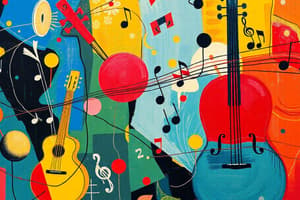Podcast
Questions and Answers
What are the distinctive musical elements of 20th century music?
What are the distinctive musical elements of 20th century music?
Polyrhythm, unusual meters, multimeter, syncopation, whole-tone scale, pentatonic scale, twelve-tone system.
Which of the following describes polyrhythm?
Which of the following describes polyrhythm?
- Use of whole intervals in a scale
- Changes in meter within a composition
- Accents placed on weak beats
- Simultaneous sounding of contrasting layers of rhythmic patterns (correct)
What is an unusual meter?
What is an unusual meter?
- A scale with five tones
- A type of syncopation
- The use of standard 4/4 time
- A meter that uses uncommon groupings like 5, 7, or 11 (correct)
Syncopation occurs when accents are placed on strong beats.
Syncopation occurs when accents are placed on strong beats.
What is the pentatonic scale?
What is the pentatonic scale?
Match the musical terms with their definitions:
Match the musical terms with their definitions:
Which of the following represents a significant feature of 20th century music's timbre-dynamic element?
Which of the following represents a significant feature of 20th century music's timbre-dynamic element?
Ano ang pangunahing layunin ng mitolohiya?
Ano ang pangunahing layunin ng mitolohiya?
Ang mga diyos at diyosa ay hindi mahalaga sa mitolohiya.
Ang mga diyos at diyosa ay hindi mahalaga sa mitolohiya.
Ibigay ang isang halimbawa ng mitolohiyang Pilipino.
Ibigay ang isang halimbawa ng mitolohiyang Pilipino.
Ang _____ ay kwentong naglalarawan ng mga pinagmulan ng mga bagay-bagay o lugar.
Ang _____ ay kwentong naglalarawan ng mga pinagmulan ng mga bagay-bagay o lugar.
I-match ang mga uri ng mitolohiya sa kanilang kahulugan:
I-match ang mga uri ng mitolohiya sa kanilang kahulugan:
Alin sa mga sumusunod ang hindi kabilang sa mga elemento ng mitolohiya?
Alin sa mga sumusunod ang hindi kabilang sa mga elemento ng mitolohiya?
Ang mitolohiyang Griyego ay walang kinalaman sa mga kwento nina Zeus at Hera.
Ang mitolohiyang Griyego ay walang kinalaman sa mga kwento nina Zeus at Hera.
Ano ang isa sa mga tema sa mitolohiya?
Ano ang isa sa mga tema sa mitolohiya?
Ang pag-aaral ng mitolohiya ay isang _____ na larangan na kinabibilangan ng kasaysayan at antropolohiya.
Ang pag-aaral ng mitolohiya ay isang _____ na larangan na kinabibilangan ng kasaysayan at antropolohiya.
Bakit mahalaga ang mitolohiya sa kultura?
Bakit mahalaga ang mitolohiya sa kultura?
Study Notes
Basic Information
- Learn essential details for identifying students in the lesson, such as name, year, section, teacher, score, and date.
Activity Title: Music of the 20th Century
- Focus on analyzing distinctive musical elements in 20th-century styles.
Distinctive Musical Elements of 20th Century Music
- Composers introduced innovative rhythms and meters, enhancing the complexity of music.
- Polyrhythm: Contrasting rhythmic patterns played simultaneously, adding depth to compositions.
- Unusual meters: Includes uncommon metric groupings like 5, 7, or 11, creating unique rhythmic frameworks.
- Multimeter: Changes in meter within a single piece, providing variety and interest.
- Syncopation: Accents placed on weak beats, producing a fresh rhythmic feel.
- Melodic structures feature distinctive scales:
- Whole-tone scale: Composed entirely of whole intervals, generates a dreamlike sound.
- Pentatonic scale: A five-tone scale that creates a simplified melody.
- Twelve-tone system: Utilizes all twelve chromatic tones, foundational for serialism.
- A significant emphasis on dynamic range and unusual instrumental combinations, pioneering new timbral effects.
- Polyphonic texture: The simultaneous combination of two or more melodies, enriching the listening experience.
Definition of Mythology
- A collection of stories or legends featuring gods, goddesses, and heroes.
- Commonly explains the creation of the world, nature, and humanity.
Elements of Mythology
- Gods and Goddesses: Powerful beings representing various aspects of life.
- Heroes: Characters with extraordinary strength or qualities, often engaged in journeys or battles.
- Legends: Narratives that describe the origins of objects or places.
Importance of Mythology
- Reflects the beliefs and culture of a society.
- Provides explanations for natural phenomena and conveys moral lessons.
- Serves as a foundation for rituals and traditions.
Types of Mythology
- Cosmogonic Myths: Concerned with the creation of the world.
- Theogonic Myths: Focus on the creation of gods and their relationships.
- Heroic Myths: Tell stories of heroes and their adventures.
Examples of Mythology
- Greek Mythology: Stories featuring Zeus, Hera, and Achilles.
- Roman Mythology: Narratives involving Jupiter, Venus, and Aeneas.
- Philippine Mythology: Tales of Bathala, Maria Makiling, and Si Malakas and Si Maganda.
Themes in Mythology
- The struggle between good and evil.
- Trials and self-discovery of individual capabilities.
- The relationship between humanity and nature.
Influence of Mythology
- Affects art, literature, and contemporary culture.
- Serves as inspiration for movies, books, and various media forms.
Study of Mythology
- An interdisciplinary field that includes history, anthropology, and literature.
- Essential for understanding ancient societies and their perspectives on life.
Studying That Suits You
Use AI to generate personalized quizzes and flashcards to suit your learning preferences.
Related Documents
Description
This quiz focuses on the distinctive musical elements found in 20th-century music. Students will analyze various pieces and describe their unique characteristics. It aligns with the learning targets outlined in the Horizon Grade 10 Learner's Materials.




